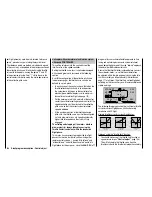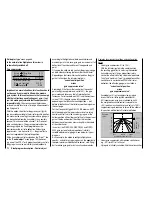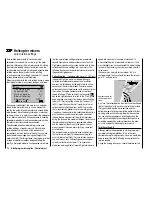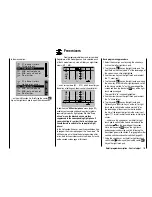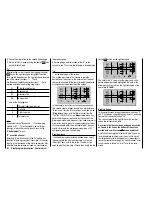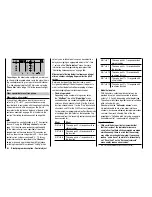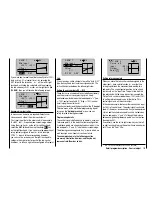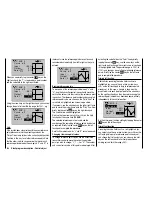
178
Detail program description - Control adjust
Auto-rotation permits both full-size and model
helicopters to land safely in a crisis, e. g. if the motor
should fail. Moreover, if the tail rotor should fail, cutting
the motor and landing using auto-rotation is also the
only possible way to avoid a high-speed, uncontrollable
rotation around the vertical axis and a resulting
catastrophic crash. Accordingly, switchover TO the auto-
rotation phase takes place immediately.
When the switchover to the auto-rotation phase is made,
the Helicopter mixer menu screen changes as follows:
Pitch
Thr setting AR
Tailoffset AR
Gyro suppress
0%
Swash rotation
0°
OFF
Autorot
–90%
0%
Swash limiter
During auto-rotation fl ight, the main rotor is no longer
driven by the motor, but only by its own momentum
and the the airfl ow through the rotor disc caused by the
rapid descent. Since the energy stored by a rotor kept
spinning in this way is rapidly consumed if the helicopter
fl ares, pilots must not only have experience in handling
helicopter models but must also consider carefully how
the relevant functions should be confi gured.
The advanced pilot should therefore practice auto-
rotation landings at regular intervals. Not only to be
able to demonstrate mastery of the maneuver at
competitions, but also to ensure the pilot can can land
the helicopter undamaged from a great height if the
motor should fail. For this purpose, the program provides
a range of adjustment options designed to help the
pilot fl y a motorized model in its unpowered state. Note
Helicopter mixers
Auto-rotation settings
that the auto-rotation settings comprise a complete
seventh fl ight phase, which provides access to all the
fl ight phase- specifi c confi guration options, and to trims,
collective pitch curve settings, etc., in particular. The
following functions have special features not present in
the powered fl ight phases:
Collective pitch
(Collective pitch curve (C1
Pitch))
In powered fl ight, the maximum blade pitch angle
is limited by available motor power. In auto-rotation,
however, it is limited only by the point at which airfl ow
ceases over the main rotor blades. Greater maximum
collective pitch must therefore be set to ensure suffi cient
thrust when fl aring the helicopter even as rotational
speed is falling off. To do so, briefl y tap the center
SET
key on the right touch pad to switch to the "Pitch" graph
page and then use the joystick to move the vertical line
to point "H". Start by setting a value that is about 10%
to 20%
larger
than your "normal" maximum value for
collective pitch. Initially, however, do NOT set a value
that is
considerably
greater than for normal fl ight, since
if you do so, the behavior of the collective pitch controls
may then be very unfamiliar following the switchover.
Indeed, there is a danger that the pilot will oversteer
during the fl are and the model will balloon: this will case
the rotor speed to collapse at a considerable altitude
and the model will then crash to the ground. You can
always re-adjust the value later after fl ying some test
auto-rotations.
The minimum value for collective pitch
can
differ from
that set for normal fl ight. This depends on the pilot's
usual style for normal fl ight. For auto-rotation, however,
you must always set a suffi ciently generous minimum
value for collective pitch at point "L" to ensure your
model can be brought out of forward fl ight at moderate
speed into a descent at an angle of around 60–70°
when collective pitch is reduced to a minimum. If, like
most heli pilots, you have confi gured this kind of setting
for normal fl ight anyway, then you can simply copy this
value across.
If, however, you normally let your model "fall" at a
shallower angle, then you should increase the value at
point "L", and vice versa.
Approach angle for
various wind condi-
tions
Approach angle
in moderate
wind
no wind
45°
60°
75°
in strong
wind
As a rule, the collective pitch stick itself is not positioned
right at the bottom of its travel for auto-rotation. Instead,
it is typically between the hover position and the
bottom end-point, offering the pilot the option of further
adjusting pitch inclination using the pitch-axis controls.
You can shorten the approach by pulling back on the
pitch-axis stick and gently reducing collective pitch, or
extend the approach by pushing forward on the pitch-
axis stick and gently increasing collective pitch.
Throttle setting AR
Although pilots will be expected to cut the glow motor
completely during competitions, this is rather less
advisable during training sessions, since you would then
need to restart the motor following each practice auto-
rotation landing.
During the training phase, you should therefore set the
Summary of Contents for mx-20 Hott
Page 41: ...41 Your notes...
Page 49: ...49 Your notes...
Page 55: ...55 Your notes...
Page 81: ...81 Your notes...
Page 85: ...85 Your notes...
Page 89: ...89 Your notes...
Page 99: ...99 Detail program description Control adjust...
Page 127: ...127 Detail program description Control adjust...
Page 131: ...131 Detail program description Control adjust...
Page 163: ...163 Detail program description Control adjust...
Page 191: ...191 Detail program description Control adjust...
Page 207: ...207 Detail program description Control adjust...
Page 228: ...228 Detail program description Control adjust...
Page 229: ...229 Detail program description Control adjust...
Page 251: ...251 Detail program description Control adjust...





